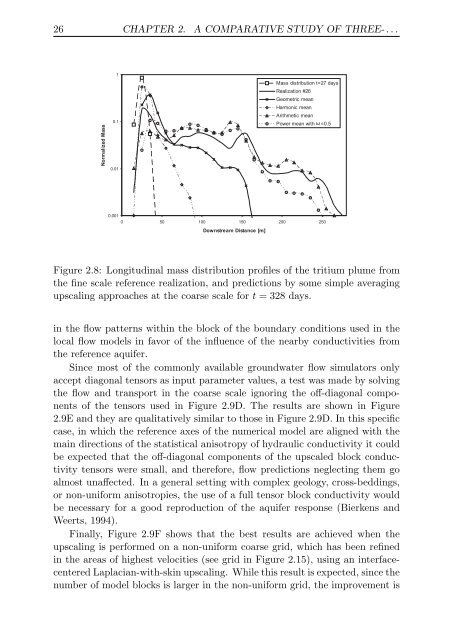Upscaling and Inverse Modeling of Groundwater Flow and Mass ...
Upscaling and Inverse Modeling of Groundwater Flow and Mass ...
Upscaling and Inverse Modeling of Groundwater Flow and Mass ...
Create successful ePaper yourself
Turn your PDF publications into a flip-book with our unique Google optimized e-Paper software.
26 CHAPTER 2. A COMPARATIVE STUDY OF THREE- . . .<br />
Normalized <strong>Mass</strong><br />
1<br />
0.1<br />
0.01<br />
0.001<br />
0 50 100 150 200 250<br />
Downstream Distance [m]<br />
<strong>Mass</strong> distribution t=27 days<br />
Realization #26<br />
Geometric mean<br />
Harmonic mean<br />
Arithmetic mean<br />
Power mean with ω =0.5<br />
Figure 2.8: Longitudinal mass distribution pr<strong>of</strong>iles <strong>of</strong> the tritium plume from<br />
the fine scale reference realization, <strong>and</strong> predictions by some simple averaging<br />
upscaling approaches at the coarse scale for t = 328 days.<br />
in the flow patterns within the block <strong>of</strong> the boundary conditions used in the<br />
local flow models in favor <strong>of</strong> the influence <strong>of</strong> the nearby conductivities from<br />
the reference aquifer.<br />
Since most <strong>of</strong> the commonly available groundwater flow simulators only<br />
accept diagonal tensors as input parameter values, a test was made by solving<br />
the flow <strong>and</strong> transport in the coarse scale ignoring the <strong>of</strong>f-diagonal components<br />
<strong>of</strong> the tensors used in Figure 2.9D. The results are shown in Figure<br />
2.9E <strong>and</strong> they are qualitatively similar to those in Figure 2.9D. In this specific<br />
case, in which the reference axes <strong>of</strong> the numerical model are aligned with the<br />
main directions <strong>of</strong> the statistical anisotropy <strong>of</strong> hydraulic conductivity it could<br />
be expected that the <strong>of</strong>f-diagonal components <strong>of</strong> the upscaled block conductivity<br />
tensors were small, <strong>and</strong> therefore, flow predictions neglecting them go<br />
almost unaffected. In a general setting with complex geology, cross-beddings,<br />
or non-uniform anisotropies, the use <strong>of</strong> a full tensor block conductivity would<br />
be necessary for a good reproduction <strong>of</strong> the aquifer response (Bierkens <strong>and</strong><br />
Weerts, 1994).<br />
Finally, Figure 2.9F shows that the best results are achieved when the<br />
upscaling is performed on a non-uniform coarse grid, which has been refined<br />
in the areas <strong>of</strong> highest velocities (see grid in Figure 2.15), using an interfacecentered<br />
Laplacian-with-skin upscaling. While this result is expected, since the<br />
number <strong>of</strong> model blocks is larger in the non-uniform grid, the improvement is


